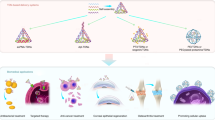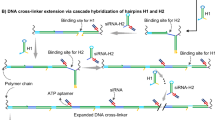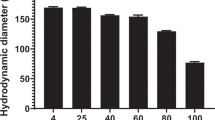Abstract
Nonviral transfection of mammalian cells can be performed with electrostatic complexes (polyplexes) between a plasmid DNA (pDNA) encoding a foreign gene and a cationic polymer. However, an excess of the cationic polymer is required for pDNA condensation and polyplexes formation, which generate in vivo toxicity. Here, we present a new concept of polyplexes preparation aiming to reduce the polymer quantity. pDNA was functionalized with 3,6,9-trioxaundecan-1- {4 - [(2-chloroethyl) ethylamino)] - benzylamino}, 11-azide, and polyethyleneimine (lPEI) with reducible dibenzocyclooctyl (SS-DBCO) groups allowing azide-alkyne cycloaddition between pDNA and lPEI after condensation. The size of polyplexes with DBCO-SS-lPEI was smaller than with lPEI due to a stronger DNA condensation thanks to linkages between polymer and pDNA preventing dissociation until disulfide bridges reduction. In vitro transfection showed that the amount of DBCO-SS-lPEI leading to the most efficient polyplexes was three times lower than lPEI. As expected, toxicity in mice was significantly reduced upon intravenous injection of DBCO-SS-lPEI polyplexes at doses where the lPEI polyplexes killed mice. This is probably due to the high stability of the DBCO-SS-lPEI polyplexes which prevented their aggregation in the pulmonary capillaries. Overall, this new concept of polyplexes with DBCO-SS-lPEI offering the possibility of administering higher doses of polyplexes than lPEI and their ability to pass the pulmonary barrier could be favorably exploited for transfection of distant organs or tissues, such as tumors.
This is a preview of subscription content, access via your institution
Access options
Subscribe to this journal
Receive 12 print issues and online access
$259.00 per year
only $21.58 per issue
Buy this article
- Purchase on Springer Link
- Instant access to full article PDF
Prices may be subject to local taxes which are calculated during checkout









Similar content being viewed by others
Data availability
The data generated and analyzed during the current study are available from the corresponding author upon reasonable request.
References
Lundstrom K. Gene therapy today and tomorrow. Diseases. 2019;7:37–47.
Uddin F, Rudin CM, Sen T. CRISPR gene therapy: applications, limitations, and implications for the future. Front Oncol. 2020;10:1387.
Watanabe N, McKenna MK, Rosewell Shaw A, Suzuki M. Clinical CAR-T cell and oncolytic virotherapy for cancer treatment. Mol Ther. 2021;29:505–20.
Duan D. Systemic AAv micro-dystrophin gene therapy for Duchenne muscular dystrophy. Mol Ther. 2018;26:2337–56.
Manno CS, Pierce GF, Arruda VR, Glader B, Ragni M, Rasko JJ, et al. Successful transduction of liver in hemophilia by AAV-Factor IX and limitations imposed by the host immune response. Nat Med. 2006;12:342–7.
Nathwani AC, Rosales C, McIntosh J, Rastegarlari G, Nathwani D, Raj D, et al. Long-term safety and efficacy following systemic administration of a self-complementary AAV vector encoding human FIX pseudotyped with serotype 5 and 8 capsid proteins. Mol Ther. 2011;19:876–85.
Nathwani AC, Tuddenham EG, Rangarajan S, Rosales C, McIntosh J, Linch DC, et al. Adenovirus-associated virus vector-mediated gene transfer in hemophilia B. N Engl J Med. 2011;365:2357–65.
Nienhuis AW, Nathwani AC, Davidoff AM. Gene therapy for hemophilia. Mol Ther. 2017;25:1163–7.
Patil S, Gao YG, Lin X, Li Y, Dang K, Tian Y, et al. The development of functional non-viral vectors for gene delivery. Int J Mol Sci. 2019;20:5491–504.
Chen CK, Huang PK, Law WC, Chu CH, Chen NT, Lo LW. Biodegradable polymers for gene-delivery applications. Int J Nanomed. 2020;15:2131–50.
Wahane A, Waghmode A, Kapphahn A, Dhuri K, Gupta A, Bahal R. Role of lipid-based and polymer-based non-viral vectors in nucleic acid delivery for next-generation gene therapy. Molecules. 2020;25:2866–89.
Mashel TV, Tarakanchikova YV, Muslimov AR, Zyuzin MV, Timin AS, Lepik KV, et al. Overcoming the delivery problem for therapeutic genome editing: current status and perspective of non-viral methods. Biomaterials. 2020;258:120282.
Urello M, Hsu WH, Christie RJ. Peptides as a material platform for gene delivery: emerging concepts and converging technologies. Acta Biomater. 2020;117:40–59.
Urello MA, Xiang L, Colombo R, Ma A, Joseph A, Boyd J, et al. Metabolite-based modification of poly(l-lysine) for improved gene delivery. Biomacromolecules. 2020;21:3596–607.
Golan R, Pietrasanta LI, Hsieh W, Hansma HG. DNA toroids: stages in condensation. Biochemistry. 1999;38:14069–76.
Mann A, Richa R, Ganguli M. DNA condensation by poly-L-lysine at the single molecule level: role of DNA concentration and polymer length. J Control Release. 2008;125:252–62.
Sun C, Tang T, Uludag H. Molecular dynamics simulations of PEI mediated DNA aggregation. Biomacromolecules. 2011;12:3698–707.
Sun C, Tang T, Uludag H, Cuervo JE. Molecular dynamics simulations of DNA/PEI complexes: effect of PEI branching and protonation state. Biophys J. 2011;100:2754–63.
Widom J, Baldwin RL. Cation-induced toroidal condensation of DNA studies with Co3+(NH3)6. J Mol Biol. 1980;144:431–53.
Lucas P, Milroy DA, Thomas BJ, Moss SH, Pouton CW. Pharmaceutical and biological properties of poly(amino acid)/DNA polyplexes. J Drug Target. 1999;7:143–56.
Ramsay E, Hadgraft J, Birchall J, Gumbleton M. Examination of the biophysical interaction between plasmid DNA and the polycations, polylysine and polyornithine, as a basis for their differential gene transfection in-vitro. Int J Pharm. 2000;210:97–107.
Xu Y, Szoka FC Jr. Mechanism of DNA release from cationic liposome/DNA complexes used in cell transfection. Biochemistry. 1996;35:5616–23.
Pigeon L, Goncalves C, Pichon C, Midoux P. Evidence for plasmid DNA exchange after polyplex mixing. Soft Matter. 2016;12:7012–9.
Bacalocostantis I, Mane VP, Goodley AS, Bentley WE, Muro S, Kofinas P. Investigating polymer thiolation in gene delivery. J Biomater Sci Polym Ed. 2013;24:912–26.
Bacalocostantis I, Mane VP, Kang MS, Goodley AS, Muro S, Kofinas P. Effect of thiol pendant conjugates on plasmid DNA binding, release, and stability of polymeric delivery vectors. Biomacromolecules. 2012;13:1331–9.
McKenzie DL, Kwok KY, Rice KG. A potent new class of reductively activated peptide gene delivery agents. J Biol Chem. 2000;275:9970–7.
McKenzie DL, Smiley E, Kwok KY, Rice KG. Low molecular weight disulfide cross-linking peptides as nonviral gene delivery carriers. Bioconjug Chem. 2000;11:901–9.
Russ V, Frohlich T, Li Y, Halama A, Ogris M, Wagner E. Improved in vivo gene transfer into tumor tissue by stabilization of pseudodendritic oligoethylenimine-based polyplexes. J Gene Med. 2010;12:180–93.
Trubetskoy VS, Budker VG, Hanson LJ, Slattum PM, Wolff JA, Hagstrom JE. Self-assembly of DNA-polymer complexes using template polymerization. Nucleic Acids Res. 1998;26:4178–85.
Chollet P, Favrot MC, Hurbin A, Coll JL. Side-effects of a systemic injection of linear polyethylenimine-DNA complexes. J Gene Med. 2002;4:84–91.
Clamme JP, Azoulay J, Mely Y. Monitoring of the formation and dissociation of polyethylenimine/DNA complexes by two-photon fluorescence correlation spectroscopy. Biophys J. 2003;84:1960–8.
Godbey WT, Wu KK, Mikos AG. Poly(ethylenimine)-mediated gene delivery affects endothelial cell function and viability. Biomaterials. 2001;22:471–80.
Morimoto K, Nishikawa M, Kawakami S, Nakano T, Hattori Y, Fumoto S, et al. Molecular weight-dependent gene transfection activity of unmodified and galactosylated polyethyleneimine on hepatoma cells and mouse liver. Mol Ther. 2003;7:254–61.
Regnstrom K, Ragnarsson EG, Koping-Hoggard M, Torstensson E, Nyblom H, Artursson P. PEI - a potent, but not harmless, mucosal immuno-stimulator of mixed T-helper cell response and FasL-mediated cell death in mice. Gene Ther. 2003;10:1575–83.
Boeckle S, von Gersdorff K, van der Piepen S, Culmsee C, Wagner E, Ogris M. Purification of polyethylenimine polyplexes highlights the role of free polycations in gene transfer. J Gene Med. 2004;6:1102–11.
Fahrmeir J, Gunther M, Tietze N, Wagner E, Ogris M. Electrophoretic purification of tumor-targeted polyethylenimine-based polyplexes reduces toxic side effects in vivo. J Control Release. 2007;122:236–45.
Ciolina C, Byk G, Blanche F, Thuillier V, Scherman D, Wils P. Coupling of nuclear localization signals to plasmid DNA and specific interaction of the conjugates with importin alpha. Bioconjug Chem. 1999;10:49–55.
Neves C, Byk G, Scherman D, Wils P. Coupling of a targeting peptide to plasmid DNA by covalent triple helix formation. FEBS Lett. 1999;453:41–45.
Sebestyen MG, Ludtke JJ, Bassik MC, Zhang G, Budker V, Lukhtanov EA, et al. DNA vector chemistry: the covalent attachment of signal peptides to plasmid DNA. Nat Biotechnol. 1998;16:80–85.
Slattum PS, Loomis AG, Machnik KJ, Watt MA, Duzeski JL, Budker VG, et al. Efficient in vitro and in vivo expression of covalently modified plasmid DNA. Mol Ther. 2003;8:255–63.
Branden LJ, Mohamed AJ, Smith CI. A peptide nucleic acid-nuclear localization signal fusion that mediates nuclear transport of DNA. Nat Biotechnol. 1999;17:784–7.
Roulon T, Coulaud D, Delain E, Le Cam E, Helene C, Escude C. Padlock oligonucleotides as a tool for labeling superhelical DNA. Nucleic Acids Res. 2002;30:E12.
Roulon T, Helene C, Escude C. Coupling of a targeting peptide to plasmid DNA using a new type of padlock oligonucleotide. Bioconjug Chem. 2002;13:1134–9.
Gao H, Goncalves C, Maze D, Pichon C, Midoux P. CEBA: a new heterobifunctional reagent for plasmid DNA functionalization by click chemistry. Int J Pharm. 2021;601:120566.
Bertrand E, Goncalves C, Billiet L, Gomez JP, Pichon C, Cheradame H, et al. Histidinylated linear PEI: a new efficient non-toxic polymer for gene transfer. Chem Commun. 2011;47:12547–9.
Kilkenny C, Browne WJ, Cuthill IC, Emerson M, Altman DG. Improving bioscience research reporting: the ARRIVE guidelines for reporting animal research. PLoS Biol. 2010;8:e1000412.
Wightman L, Kircheis R, Rossler V, Carotta S, Ruzicka R, Kursa M, et al. Different behavior of branched and linear polyethylenimine for gene delivery in vitro and in vivo. J Gene Med. 2001;3:362–72.
Merdan T, Kunath K, Petersen H, Bakowsky U, Voigt KH, Kopecek J, et al. PEGylation of poly(ethylene imine) affects stability of complexes with plasmid DNA under in vivo conditions in a dose-dependent manner after intravenous injection into mice. Bioconjug Chem. 2005;16:785–92.
Brunner S, Furtbauer E, Sauer T, Kursa M, Wagner E. Overcoming the nuclear barrier: cell cycle independent nonviral gene transfer with linear polyethylenimine or electroporation. Mol Ther. 2002;5:80–6.
Itaka K, Harada A, Yamasaki Y, Nakamura K, Kawaguchi H, Kataoka K. In situ single-cell observation by fluorescence resonance energy transfer reveals fast intra-cytoplasmic delivery and easy release of plasmid DNA complexed with linear polyethylenimine. J Gene Med. 2004;6:76–84.
Acknowledgements
We thank Stéphanie RÉTIF, Marilyne LE MEE and Sharuja NATKUNARAJAH (CIPA, CNRS-TAAM UPS44 Orléans, France) for their technical assistance in in vivo experiments.
Author information
Authors and Affiliations
Contributions
PM conceived and designed the work that led to the submission, DM and PM acquired data, and/or played an important role in interpreting the results. PM and CP drafted and revised the manuscript. PM, DM, and CP approved the final version. DM, CP, and PM agreed to be accountable for all aspects of the work in ensuring that questions related to the accuracy or integrity of any part of the work are appropriately investigated and resolved.
Corresponding author
Ethics declarations
Competing interests
The authors declare no competing interests.
Additional information
Publisher’s note Springer Nature remains neutral with regard to jurisdictional claims in published maps and institutional affiliations.
Rights and permissions
Springer Nature or its licensor (e.g. a society or other partner) holds exclusive rights to this article under a publishing agreement with the author(s) or other rightsholder(s); author self-archiving of the accepted manuscript version of this article is solely governed by the terms of such publishing agreement and applicable law.
About this article
Cite this article
Maze, D., Pichon, C. & Midoux, P. Reversible stabilization of DNA/PEI complexes by reducible click-linkage between DNA and polymer. A new polyplex concept for lowering polymer quantity. Gene Ther 30, 783–791 (2023). https://doi.org/10.1038/s41434-023-00386-1
Received:
Revised:
Accepted:
Published:
Issue Date:
DOI: https://doi.org/10.1038/s41434-023-00386-1



